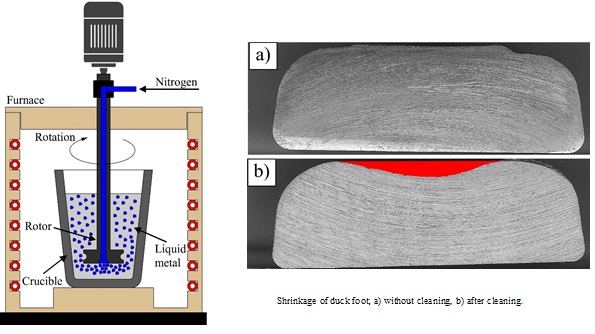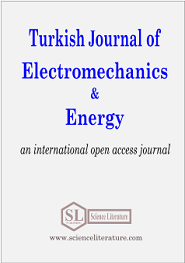
Investigation of the effect of liquid metal quality on feedability in casting of A356 aluminum alloys
Abstract
The use of aluminum in the foundry industry is basically in two different ways, from ore and scrap materials. It is very advantageous to use aluminum as secondary ingots through recycling from scrap material due to the energy inputs generated in production. However, liquid metal quality is important in the use of secondary aluminum. Because, in order to produce quality parts, it is necessary to have it free from iron-containing intermetallic phases, bifilms such as dissolved hydrogen, and inclusions that may be present in aluminum. In cases where adequate cleaning cannot be performed, the casting properties affect the final product properties in many ways. In this study, the effect of changing scrap rate and liquid metal cleaning on the feedability of A356 aluminum casting alloy was investigated. The rotary degassing method was used in the liquid metal cleaning process. Castings were made into standardized permanent molds known as duck feet molds. It has been determined that the casting of the liquid metal with cleaning can be in high quality compared to without cleaning case. Additionaly, the increase in the amount of scrap in the castings without cleaning adversely affects the feedability.
Full Text:
PDFReferences
C. R. Brooks, “Heat Treatment, Structure and Properties of Nonferrous Alloys,” American Society for Metals, Ohio, USA, 1984.
W. F. Chen, and E. M. Lui, “Handbook of structural engineering,” CRC Press, ABD, 2005.
E. Car, “Birincil alüminyum üretimine genel bir bakış,” Metalurji Dergisi, vol. 156, pp. 34-48, 2019.
M. Öztürk, “Kullanılmış alüminyum malzemelerinin geri kazanılması”, Çevre ve Orman Bakanlığı, Report, Ankara, 2005.
M. Tokatlı, F. Saydam, M. Hal, A. Koşatepe, M. Çolak and Ç. Yüksel, “Investigation of liquid metal cleaning methods commonly used in the casting of aluminum alloys,” Journal of the Institute of Science and Technology, 12(1), pp. 423-434, 2022.
M. Çolak, R. Kayikci, and D. Dispinar, “Melt cleanliness comparison of chlorine fluxing and Ar degassing of secondary Al-4Cu,” Metallurgical And Materials Transactions B, vol. 47, pp. 2705-2709, 2016.
E. Erzi, Ö. Gürsoy, Ç. Yüksel, M. Çolak, and D. Dispinar, “Determination of acceptable quality limit for casting of A356 aluminium alloy: supplier’s quality index (SQI),” Metals, 9(9), pp. 957, 2019.
F. Chiesa and P. Regimbal, “Distinguishing microporosity from macroshrinkage when modelling solidification of A356 castings,” AFS Transactions, vol. 109, pp. 347-357, 2001.
A.T. Şensoy, M. Çolak, I. Kaymaz, and D. Dispinar, “Investigating the optimum model parameters for casting process of A356 alloy: A cross-validation using response surface method and particle swarm optimization,” Arabian Journal for Science and Engineering, 45(11), pp. 9759-9768, 2020.
M. Tiryakioğlu, J.T. Staley, and J. Campbell, “Evaluating structural integrity of cast Al–7% Si–Mg alloys via work hardening characteristics: II. A new quality index,” Materials Science And Engineering: A, vol. 368, pp. 231-238, 2004.
J.G. Kaufman and E.L. Rooy, “Aluminum alloy castings, properties, processes, and applications,” ASM International, American Foundry Society, USA, 2005.
D. Dışpınar and J. Campbell, “Alüminyum ve alaşımlarının döküm kalitesinin belirlenmesi,” Alüminyum sempozyumu, İstanbul, 2009.
S. Öztürk, S. E. Sünbül, K. İcin, B. Öztürk, “Production of AA 2024 aluminum alloy ribbons by melt spinning process,” Turkish Journal of Electromechanics & Energy, 2(2), pp.14-19, 2017.
D. Dışpınar and J. Campbell, “Porosity, hydrogen and bifilm content in Al alloy castings,” Materials Science and Engineering A, vol. 528, pp. 3860–3865, 2011.
M. Çolak, “Modification of eutectic Al–Si alloys by Sr and CuSn5,” Materials Research Express, 6(10), pp. 10652, 2009.
M. Colak, R. Kayikci, and D. Dispinar, “Influence of different cross sections on fluidity characteristics of A356,” Transactions of the Indian Institute of Metals, 68(2), pp. 275-281, 2015.
E. Uslu and S. H. Yetgin, “Investigation of the effect of mechanical vibration, cooling plate and grain refinement in sand molding of a360 aluminum casting alloy,” TURAN-CSR: TURAN Center for Strategic Researches, 13(52), pp. 228-234, 2021.
M. Dıvandarı and J. Campbell, “The mechanism of bubble damage in castings,” 1st International Conference on Gating, Filling and Feeding of Aluminum Castings AFS Society, pp. 49-63, 1999.
D.P. Lapham, C. Schwandt, M.P. Hills, R.V. Kumar, and D.J. Fray, “The detection of hydrogen in molten aluminium,” ionics, pp. 391-401, 2002.
R.C. Atwood, S. Srıdhar, W. Zhang and P.D. Lee, “Diffusion-controlled growth of hydrogen pores aluminum-silicon casting: in situ observation and modelling,” Acta Materialia., vol. 48, pp. 405-417, 2008.
L. Liu and F.H. Samuel, “Effect of inclusions on the tensile properties of Al–7% Si–0.35% Mg (A356.2) aluminum casting alloy,” Journal of Materials Science, 33(9), pp. 2269-2281, 1998.
E. Ayran and M. Pekedis, “Validation of Experimental Impact Tests on Aluminum Alloy Car Wheels using the Finite Element Method,” Dicle University Journal of Engineering (DUJE), 11(2), pp. 663-670, 2019.
M. Çolak and İ. Arslan, “Investigation of effect of mold preheating temperature on feeding on aluminum alloys in die casting,” The Black Sea Journal of Sciences, 8(2), pp. 131-140, 2018.
A.S. Sabau and S. Viswanathan, “Microporosity prediction in aluminum alloy castings.” Metallurgical and Materials Transactions B, 33(2), pp. 243-255, 2002.
URN: https://sloi.org/urn:sl:tjoee73251
Copyright (c) 2022 Turkish Journal of Electromechanics and Energy

This work is licensed under a Creative Commons Attribution-NonCommercial 4.0 International License.

 Indexed in:
Indexed in:
















